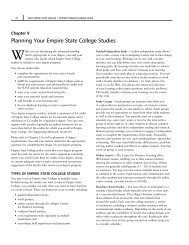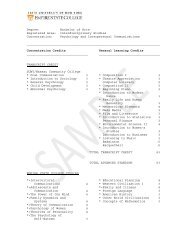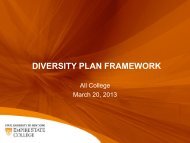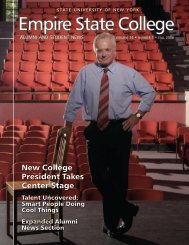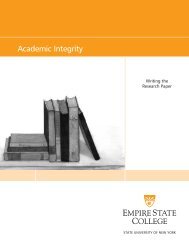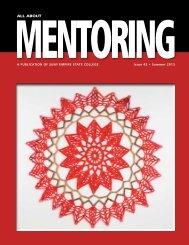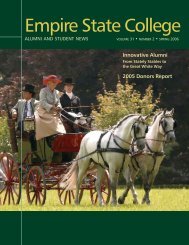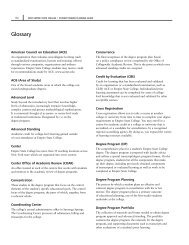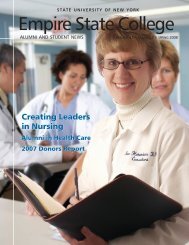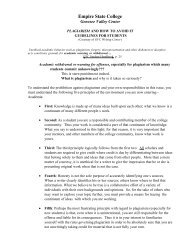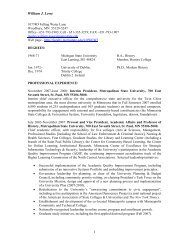Academic Plan 2011-2015 (PDF 524kB) - SUNY Empire State College
Academic Plan 2011-2015 (PDF 524kB) - SUNY Empire State College
Academic Plan 2011-2015 (PDF 524kB) - SUNY Empire State College
You also want an ePaper? Increase the reach of your titles
YUMPU automatically turns print PDFs into web optimized ePapers that Google loves.
<strong>SUNY</strong> <strong>Empire</strong> <strong>State</strong> <strong>College</strong>: <strong>Academic</strong> <strong>Plan</strong> <strong>2011</strong> - <strong>2015</strong> 7Faculty throughout the college communicated a determination to preserve the centrality of thestudents’ role in fashioning the course of their education. As the college has evolved and grown, itscapacity for advancing this model has increased correspondingly. Building on the student-centeredarchetype, programs which prepare students to achieve their professional goals fit well with thestrategic direction of the college. Indeed, the college’s Vision <strong>2015</strong> stipulates that “the college willenhance its ability to support students in their learning, and employees in their work,” and programsrelating to the latter have been assuming greater institutional significance. Programs which focus onstrengthening professional skills complement the liberal arts and adult learner traditions because theyallow the college to serve learner interests more comprehensively. Moreover, the professional-basedcurricula bear the stamp of values that typify the college’s liberal arts tradition. For example, emphaseson ethics are revealed in the college’s commitment to learner goals which foster students’ desire toemploy their education in the service of sustaining and improving their organizations and communitiesand to use environmental resources with care and reverence.Faculty also expressed an appreciation for the distinct benefits to our students if we approach ourcollection of disciplines as though they are naturally compatible. Consider that students in businessprograms must learn skills relating to empathy, a trait vital to managerial effectiveness that may belearned from exposure to great works of literature in addition to business textbooks. Artists maylearn about how to develop business plans so they can imagine ways of making their craft work forthem as a career. Health care practitioners may learn about social policy to become sensitized tothe ethical and societal impact of their choices about who should receive health care coverage. In amore interdisciplinary environment, such richness of educational possibility occupies a more dynamicpresence in the dialogue about program development and curriculum design. In more traditionalhigher educational environments, disciplinary boundaries tend to be more fixed; in a student-centeredcontext, learner needs and aspirations occupy a more pronounced role in degree planning.<strong>SUNY</strong> <strong>Empire</strong> <strong>State</strong> <strong>College</strong>’s regional center model represents both an enormous asset in this academicplanning endeavor, as well as a challenge. This model, that organizes the undergraduate program byregional location, constitutes a proud tradition for the college. It has enabled students to bring theperspectives of their communities to the learning environment and, at the same time, has allowedthe college to have a presence in communities in which our students work and live. The regionalcenter model, therefore, meets the personal and professional needs of our students, creates uniquepossibilities in terms of location-based learning, and allows the college to influence and be influencedby the character and culture of our students’ communities.While the distributive nature of the college brings the college out to the wider environment, there is, ofcourse, the risk that it can amplify a sense of division among programs and centers and other structuresby which the college is organized to provide academic services. Set against the challenge created bythis tendency is the clear call from faculty for a more vigorous interdisciplinary orientation towardprogram planning and educational delivery. This desire is expressed as deriving from core college valueswhich place the student at the center of the college’s work.In order to abide by these values, it is important to consider that the educational experience mostbeneficial for a given student may require going outside the confines of the student’s geographiclocation, curricular concentration, or the program in which the student is primarily housed. Or itmay mean that creating a smooth path from undergraduate to graduate studies is in the student’s




